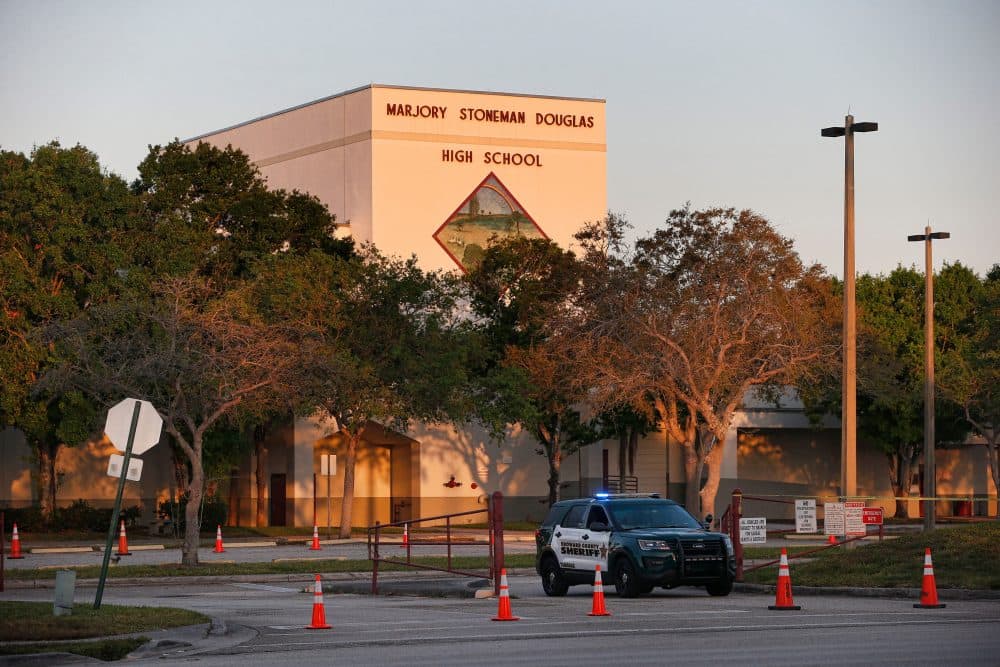Advertisement
'Toxic Masculinity' Deserves More Scrutiny As Factor In School Attacks, Researcher Says
Resume
What's going on in the mind of a person who wants to commit violence at a school? One researcher who focuses on averted attacks says he's found clear patterns.
Here & Now's Robin Young speaks with Eric Madfis (@DrEricMadfis), associate professor of criminal justice at the University of Washington Tacoma.
Interview Highlights
On what he's learned about young people who plan school attacks that are thwarted
"The vast majority are boys. And so I do think that looking at forms of toxic masculinity, why it is boys lash out in this way. ... And so a lot of it is about, you failed in other avenues of your life — you can't be popular, you're not necessarily financially successful, whatever it may be that would be traditional avenues of performing your masculinity. Instead, you do the show of power, a lot of it does have to do with boys who feel emasculated. So I do think looking at the gender dynamics, and particularly having mental health counseling and these kind of approaches that look at masculinity, is really important."
"It's when kids come forward to the authorities — sometimes to parents, to teachers, to sometimes school resource officers — to report this behavior, that's actually what averts these situations."
Eric Madfis
On common traits among those who plan to carry out a school attack
"They do tend to be people who have experienced lots of frustrations throughout their lives. They tend to be people who have not been successful in the way that they want to be. But in school shooters, there is a number of cases where people have been suspended or expelled or something like that beforehand, which acts as sort of like a last straw before these attacks. So that's not atypical."
On what he's learned from studying averted school attacks about the best ways to prevent them
"I think in particular what we know is, what actually averted these attacks, when I looked at the schools across the country, what it really was was people coming forward when they had been exposed to some sort of threat that they had heard about, whether that's a kid — and in the majority of cases there is some form of what the Secret Service called 'leakage,' some form of a kid telling someone else what they're gonna do, either by threatening them, or trying to convince them to join up on their plot, things like that. That happens in the vast majority of cases, and it's when kids come forward to the authorities — sometimes to parents, to teachers, to sometimes school resource officers — to report this behavior, that's actually what averts these situations.
"And what we also know from tons of research across education and criminal justice and sociology and all these fields, that the best way to encourage reporting behavior is a positive school environment. And you have a school environment that doesn't cramp down and is not excessively punitive in terms of its discipline, doesn't have zero-tolerance policies, when it has an environment that people feel comfortable coming to the adults in the building, that students feel comfortable with, that they can trust the people, that they're not gonna get in trouble themselves, that's when they come forward. And so having a more cramped-down, security-style environment actually makes kids less likely to come forward and make school shootings more likely to happen."
On the role of violence risk and threat assessment
"The problem is there are various forms of violence risk assessment that are based on aggregate data, and sometimes sort of stereotypes that are problematic. So the idea that there is a 'profile of school shooters' and we have to follow people who dress differently or wear trench coats or stuff like that, or like different kinds of music, that's problematic and not really empirically based.
"In contrast, we can talk about threat assessment, which is sort of a more specific thing where you're actually looking at the substance of the threat itself — how detailed the threat was, how actionable, how doable the threat was. If you threaten to blow up the moon, that's not a sort of realistic threat. But if you've actually taken actions to engage in that threat — so if you've actually collected weapons, you've written extensively about your plans to do it — those are the kind of threats that you take more seriously than someone just sort of randomly, offhandedly saying you wanna kill someone, or a threat that doesn't have the same kind of detail or realistic sort of actions taken behind it. So looking at the substance of the threat to sort of assess how serious it is."
This article was originally published on February 27, 2018.
This segment aired on February 27, 2018.